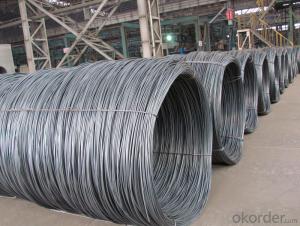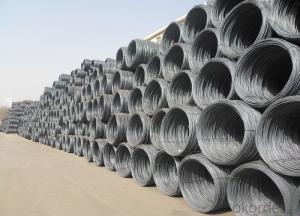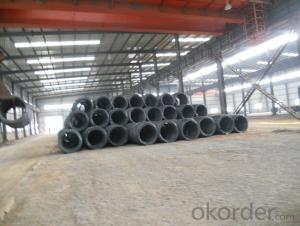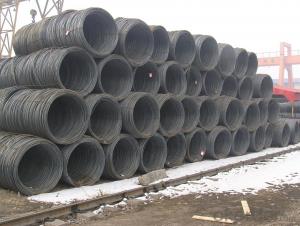Prime Alloy Hot Rolled Wire Rod in Low Carbon
- Loading Port:
- China main port
- Payment Terms:
- TT OR LC
- Min Order Qty:
- 100 m.t.
- Supply Capability:
- 10000 m.t./month
OKorder Service Pledge
OKorder Financial Service
You Might Also Like
Item specifice
Product Description:
OKorder is offering Prime Alloy Hot Rolled Wire Rod in Low Carbon at great prices with worldwide shipping. Our supplier is a world-class manufacturer of steel, with our products utilized the world over. OKorder annually supplies products to African, South American and Asian markets. We provide quotations within 24 hours of receiving an inquiry and guarantee competitive prices.
Product Applications:
Prime Alloy Hot Rolled Wire Rod in Low Carbon are ideal for structural applications and are widely used in construction and manufacturing. Carbon steel wire rod is mainly used for reinforcement of reinforced concrete and welded structure or reprocessed (roberts , nail, etc.) materials, especially used to produce wire drawing, welding electrode, nails, spring, electronic, precise machinery parts and so on.
Product Advantages:
OKorder's Prime Alloy Hot Rolled Wire Rod in Low Carbon are durable, strong, and wide variety of sizes.
Main Product Features:
· Premium quality
· Prompt delivery & seaworthy packing (30 days after receiving deposit)
· Can be recycled and reused
· Mill test certification
· Professional Service
· Competitive pricing
Product Specifications:
Manufacture: Hot rolled
Grade: HRB400,HRB400E,HRB500
Certificates: ISO, SGS, BV, CIQ
Packaging: Export packing, nude packing, in coils, each coil around 2mt
Size: 5.5mm, 6.5mm, 8mm, 10mm
Chemical composition (%): | C | Si | Mn | P | S | Ceq | |||
HRB335 HRBF335 |
0.25 |
0.80 |
1.60 |
0.045 |
0.045 | 0.52 | |||
HRB400 HRBF400 | 0.54 | ||||||||
HRB500 HRBF500 | 0.55 | ||||||||
Mechanical properties | Steel | Rel/ MPa | Rm/ MPa | A/ % | Agt/ % | ||||
≥ | |||||||||
HRB335 HRBF335 | 335 | 455 | 17 |
7.5 | |||||
HRB400 HRBF400 | 400 | 540 | 16 | ||||||
HRB500 HRBF500 | 500 | 630 | 15 | ||||||
FAQ:
Q1: Why buy Materials & Equipment from OKorder.com?
A1: All products offered byOKorder.com are carefully selected from China's most reliable manufacturing enterprises. Through its ISO certifications, OKorder.com adheres to the highest standards and a commitment to supply chain safety and customer satisfaction.
Q2: How do we guarantee the quality of our products?
A2: We have established an advanced quality management system which conducts strict quality tests at every step, from raw materials to the final product. At the same time, we provide extensive follow-up service assurances as required.
Q3: How soon can we receive the product after purchase?
A3: Within three days of placing an order, we will arrange production. The normal sizes with the normal grade can be produced within one month. The specific shipping date is dependent upon international and government factors, the delivery to international main port about 45-60days.
Images:
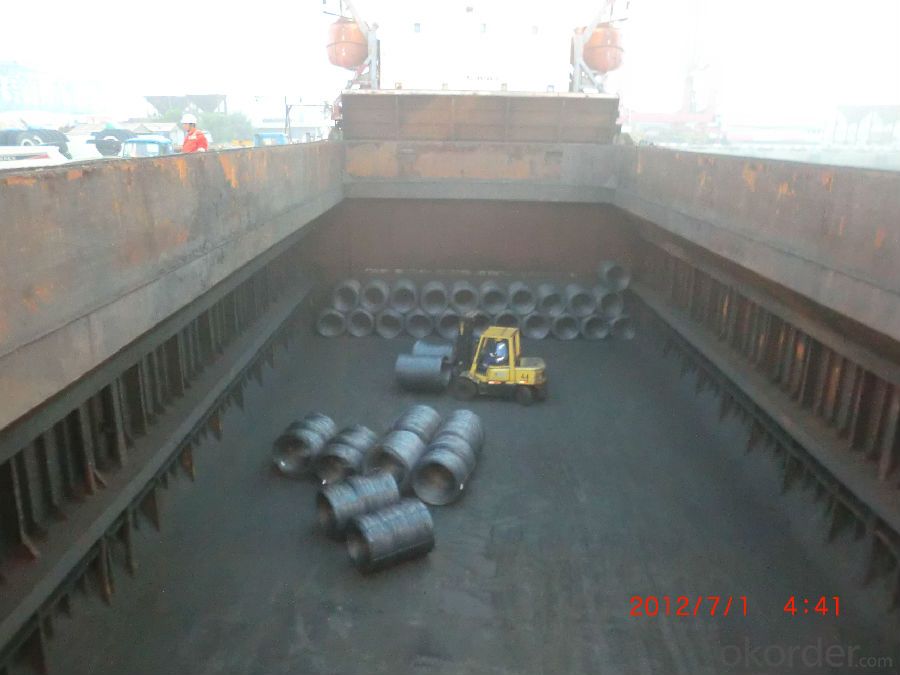

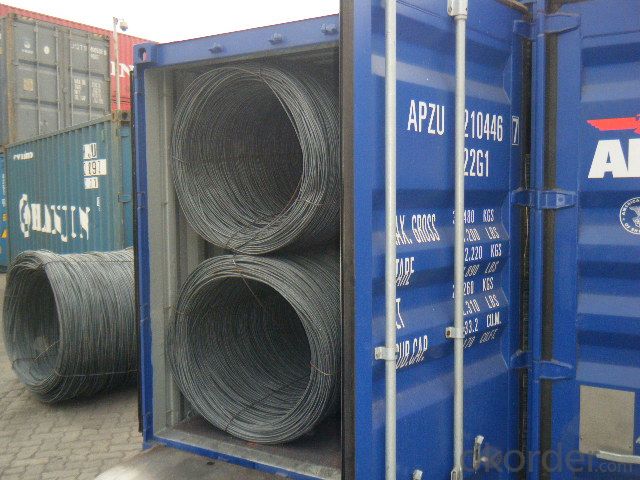
- Q:How is steel wire rod used in the production of wire for brush bristles?
- The production of wire for brush bristles relies heavily on steel wire rod. This rod, selected for its specific properties such as strength, flexibility, and durability, undergoes a series of manufacturing steps to become the desired wire. Initially, the chosen steel wire rod is drawn through a set of dies that gradually decrease its diameter and increase its length. This wire drawing process is repeated multiple times until the wire reaches the desired thickness and strength. Following wire drawing, the wire undergoes further processing to enhance its properties. This may involve heat treatment to improve strength and flexibility, as well as surface treatments like galvanization or coating to provide corrosion resistance. Once these treatments are complete, the wire is cut into lengths suitable for brush bristles. At this point, the wire can be further manipulated to develop specific brush bristle characteristics. For example, it may be twisted or crimped to enhance its cleaning or brushing capabilities. Lastly, the wire is attached to the brush base or handle to finalize the production of brush bristles. This is typically achieved using specialized machinery or techniques such as stapling or binding. In conclusion, steel wire rod is vital in the production of wire for brush bristles. It serves as the fundamental material that undergoes various manufacturing processes, including wire drawing, heat treatment, and surface treatments, to transform it into the necessary wire for brush bristles.
- Q:What are the main distribution channels for steel wire rod?
- The main distribution channels for steel wire rod include direct sales to manufacturers, wholesalers, and distributors.
- Q:How are steel wire rods used in the production of barbed wire?
- Steel wire rods are used in the production of barbed wire by being rolled and twisted together to form the central wire strand. This strand is then attached to sharp barbs, which are evenly spaced along the wire, creating the distinctive and effective deterrent of barbed wire.
- Q:How is steel wire rod used in the manufacturing of wire for mattress springs?
- Steel wire rod is used in the manufacturing of wire for mattress springs by being drawn through a series of dies to reduce its diameter to the desired thickness. This process, called wire drawing, helps in strengthening the wire and increases its tensile strength, making it suitable for use in mattress springs. The wire is then coiled and tempered to enhance its flexibility and durability, ensuring it can withstand repeated pressure and movement in the mattress.
- Q:What are the main challenges in steel wire rod production?
- Some of the main challenges in steel wire rod production include maintaining consistent quality and specifications, controlling the dimensions and surface finish of the wire rod, ensuring proper heat treatment and metallurgical properties, managing the high energy consumption and environmental impact associated with the production process, and addressing the global competition and market fluctuations in the steel industry. Additionally, ensuring the safety of workers and optimizing production efficiency are also key challenges in this sector.
- Q:What are the main factors affecting the worker safety in steel wire rod production?
- The main factors affecting worker safety in steel wire rod production include the handling of heavy machinery and equipment, exposure to hazardous substances and gases, risk of falls from elevated platforms, potential for cuts and injuries from sharp objects, and the presence of high temperatures and noise levels. Additionally, inadequate training, lack of proper safety protocols, and human error can also contribute to the overall safety risks in this industry.
- Q:How is steel wire rod tested for quality and performance?
- Steel wire rod is tested for quality and performance through a series of rigorous tests and inspections to ensure its compliance with industry standards and customer requirements. These tests are conducted at various stages of the manufacturing process, from the initial raw material to the final product. One common test performed on steel wire rod is the chemical composition analysis. This test determines the presence and quantity of various elements in the steel, such as carbon, manganese, silicon, and sulfur. It is essential to ensure that the steel composition meets the specified standards, as different compositions have different mechanical properties and performance characteristics. Mechanical testing is another crucial aspect of quality and performance evaluation. Tensile strength, yield strength, elongation, and hardness tests are conducted to assess the mechanical properties of the steel wire rod. These tests measure the ability of the rod to withstand stress, deformation, and load-bearing capacity, ensuring it meets the required strength and durability standards. Surface quality inspection is also carried out to detect any defects or irregularities on the surface of the steel wire rod. This includes the examination of the rod's appearance, such as cracks, scratches, or other surface imperfections, which could affect its performance or usability. Furthermore, dimensional and shape inspections are conducted to verify that the steel wire rod meets the specified size, diameter, and shape requirements. This ensures that the rod can be used effectively in various applications and can be easily integrated into the manufacturing processes of the end-user. In addition to these standard tests, other specialized tests may be performed based on specific customer requirements or industry regulations. These tests could include corrosion resistance, fatigue strength, or heat treatment analysis, among others. Overall, the testing of steel wire rod for quality and performance involves a comprehensive evaluation of its chemical composition, mechanical properties, surface quality, and dimensional characteristics. These tests ensure that the rod meets the necessary standards and is suitable for its intended application, providing customers with a reliable and high-performing product.
- Q:How is steel wire rod used in the manufacturing of wire for hairpins?
- Steel wire rod is used in the manufacturing of wire for hairpins by being drawn through a series of dies to reduce its diameter and increase its length. This process, known as wire drawing, allows the steel wire rod to be transformed into a thin and flexible wire, which is then further processed to create hairpin wires.
- Q:What are the different surface protection methods for steel wire rod?
- There exists a variety of surface protection methods for steel wire rods, each with different levels of protection and suitability for various applications. Some commonly used methods include: 1. Galvanization: The application of a zinc coating to the surface of the steel wire rod. Galvanization provides exceptional corrosion resistance, safeguarding the steel against moisture and chemicals. It is widely employed for outdoor or corrosive environments. 2. Coating: Steel wire rods can be coated with materials like epoxy, PVC, or polyethylene. These coatings act as a barrier between the steel surface and external factors, preventing corrosion and abrasion. They also enhance the wire's resistance to chemicals, UV radiation, and other damaging elements. 3. Phosphating: An approach that involves applying a phosphate coating to the steel wire rod. This process creates a thin layer of phosphate crystals, improving adhesion for subsequent coatings or paints. Phosphating also offers some corrosion resistance. 4. Electroplating: A method that deposits a thin layer of metal onto the steel wire rod through electrochemical means. Commonly used metals for electroplating include zinc, nickel, and chromium. This technique enhances the wire's resistance to corrosion, wear, and tarnishing. Furthermore, it adds aesthetic appeal, making it suitable for decorative purposes. 5. Powder coating: This approach entails the electrostatic application of a dry powder onto the steel wire rod, followed by curing under heat. The powder melts, forming a protective coating on the wire's surface. Powder coating provides excellent durability, resistance to corrosion, chemicals, and UV radiation. Moreover, it offers a wide range of color options and a smooth, attractive finish. Selecting the appropriate surface protection method for steel wire rods is crucial and should be based on specific requirements and the intended environment. Factors such as corrosion resistance, abrasion resistance, aesthetics, and cost-effectiveness must be considered when determining the most suitable method.
- Q:What are the common industry seminars for steel wire rod?
- Some common industry seminars for steel wire rod include events focused on wire rod production and processing techniques, market trends and developments in the steel industry, advancements in wire rod applications and uses, and discussions on quality control and standards in wire rod manufacturing.
1. Manufacturer Overview |
|
|---|---|
| Location | |
| Year Established | |
| Annual Output Value | |
| Main Markets | |
| Company Certifications | |
2. Manufacturer Certificates |
|
|---|---|
| a) Certification Name | |
| Range | |
| Reference | |
| Validity Period | |
3. Manufacturer Capability |
|
|---|---|
| a)Trade Capacity | |
| Nearest Port | |
| Export Percentage | |
| No.of Employees in Trade Department | |
| Language Spoken: | |
| b)Factory Information | |
| Factory Size: | |
| No. of Production Lines | |
| Contract Manufacturing | |
| Product Price Range | |
Send your message to us
Prime Alloy Hot Rolled Wire Rod in Low Carbon
- Loading Port:
- China main port
- Payment Terms:
- TT OR LC
- Min Order Qty:
- 100 m.t.
- Supply Capability:
- 10000 m.t./month
OKorder Service Pledge
OKorder Financial Service
Similar products
New products
Hot products
Related keywords
